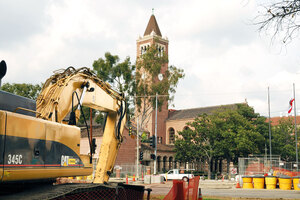Students voice support for phase two of Expo line
On the same night USC students voiced their opinions at an Expo Line Construction Authority Board meeting about the benefits of the new light rail, the board voted unanimously to extend the line from Downtown to Santa Monica.

Full steam ahead · Construction on phase one of the Expo line is underway by USC, and construction of phase two is expected to start before the end of the year now that the plan has passed. - Geo Tu| Daily Trojan
Undergraduate Student Government President Holden Slusher and about eight other students went to the meeting to lobby for passage of phase two of the light rail. Phase one, which extends from Downtown to Culver City and runs along USC’s main campus, had already been approved.
Later, after students and other advocates had spoken, the board voted 6-0 to extend the rail the seven miles from Culver City to Colorado Avenue and Fourth Street, in the heart of Santa Monica.
The public meeting lasted several hours, as hundreds of residents and students voiced their support for or concerns about phase two of the Expo line project.
Though Slusher did not get a chance to speak at the hearing, he said it was good that other students went and made their voices heard as he believes this issue is important to students.
“We need a way to get around the city,” Slusher said after the meeting.
Officials hope construction will begin on the Santa Monica portion of the line later this year. Construction on the Downtown to Culver City portion is already underway.
“It’s a really great thing for students,” said Helen Moser, USG director of Campus Affairs. “Santa Monica is a really big draw.”
Representatives for Expo Rail reached out to students at USC and UCLA, asking them to show support for phase two at Thursday’s meeting. Moser helped organize a group of students from USG and other campus organizations to speak about the impact Expo Line would have on students.
“This is obviously a great benefit to the students and the faculty,” said Samantha Bricker, chief operating officer of the Expo Line Construction Authority. “It will connect Downtown to Santa Monica and provide linkages to other transportation centers. It will also bring people into the USC Exposition Park area and provide an alternative to the 10 Freeway.”
Some who attended Thursday’s hearing said they worried that at-grade crossings at busy intersections would be dangerous. Others fretted that the crossings would create traffic jams in already congested areas. Officials are considering raising the line above some intersections, which would cost millions of dollars.
The extension will cost an estimated $1.5 billion, funding officials say they’ve already secured from local and state sources. They hope to have the Culver City to Santa Monica portion running by 2015.
“I think the Expo Line will be really great for ’SC students, and I hope that they do extend it out to Santa Monica,” said Madeline Azevedo, a freshman majoring in business administration. “There is so much to do out there, but without a car, it’s almost impossible to get there.”
Azevedo also said she would be interested in taking the train because of its low environmental impact.
Moser said, “We live in this amazing city, and it’s important that students are able to explore it.”
Whitney Blaine contributed to this report.

Have you ever taken a bus westward in LA to either the coastline or UCLA? When you do, let me know how that journey goes.
You’re absolutely right about the traffic. The authority should have demanded more money be invested so that the line could have been elevated rather than at-grade. Unfortunately, in this city, we have to settle for what we can get it or so it seems.
Tommy.. people that want to go to the Bay Area that badly will find a way. In the meanwhile people that have to drive around USC will have to deal with annoying traffic and roads that mess up their cars so that some student can take a train to Santa Monica instead of the bus like everyone else.
This is great news for USC students.
Also, I cannot wait till the high speed rail is completed. Then USC students can hop on the expo line, go to Union Station, get on the high speed, then San Francisco here we come. Though, the high speed will not be here till 2020, it will still be a great thing for the university, LA, and the bay area.